An essay outline is what makes papers more clear in comparison to poorly written works. Firstly, writers indicate main points that can be used in academic works. In principle, scholars need to have a clear map of what they want to write and discuss. Then, students can use topic and sentence frameworks with alphanumeric or decimal styles. In this case, a particular choice of format depends on the length of assignments. Moreover, students have more chances to get A+ grades by using main points because written papers will be well-organized. Therefore, essay plans are an organized set of central points that can be used in academic papers.
What Is an Essay Outline and Its Purpose
According to its definition, an essay outline is a structured framework that guides an entire writing process by organizing main points and supporting details into a coherent, logical order. Such a framework usually consists of three main sections: an introduction with a thesis statement, body paragraphs with key ideas and details, and a conclusion with a closing remark (Matthews, 2023). Firstly, an introduction part must present overall points of an essay with a writer’s thesis statement. Secondly, a section of body paragraphs must include each main point in detail, usually starting with a topic sentence followed by evidence and analysis. Thirdly, a conclusion part must wrap up a whole composition by summarizing central arguments and restating a thesis in a new light. As such, the main purpose of writing an essay outline is to provide a clear roadmap for a writer, ensuring all ideas are presented logically and cohesively (Mentan, 2022). Finally, a text’s plan is a valuable tool for creating a clear, persuasive, and well-structured paper. In terms of pages and words, the length of an essay outline depends on academic levels, assignment requirements, and subject complexities, while general guidelines are:
High School
- Length: 1-2 pages
- Word Count: 250-500 words
- Comment: Simple structure with basic points and subpoints for introduction, body paragraphs, and conclusion.
College
- Length: 2-3 pages
- Word Count: 500-750 words
- Comment: More detailed outline with specific points for each paragraph, including topic sentences, evidence, and brief analysis.
University (Undergraduate)
- Length: 3-4 pages
- Word Count: 750-1000 words
- Comment: Comprehensive outline with detailed points, including in-depth evidence and analysis for each section.
Master’s
- Length: 4-6 pages
- Word Count: 1,000-1,500 words
- Comment: Extensive outline with thorough points and subpoints, including detailed evidence, analysis, and possible counterarguments.
Ph.D.
- Length: 5-8 pages
- Word Count: 1,250-2,000 words
- Comment: Highly detailed and sophisticated outline with exhaustive points, subpoints, evidence, analysis, theoretical frameworks, and extensive references to sources.
Basic Example
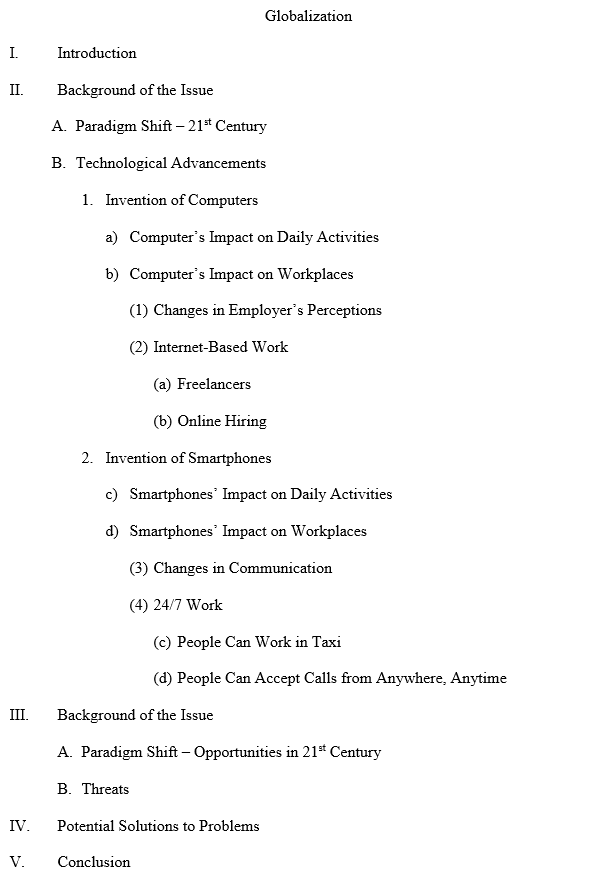
Format
| Section | Content | Description |
|---|---|---|
| Introduction | Hook | An engaging opening to grab a reader’s attention. |
| Background Information | Brief context or background information on a specific topic. | |
| Thesis Statement | A clear statement of a main argument or purpose of an essay. | |
| Body Paragraph 1 | Topic Sentence | Main idea of an entire paragraph. |
| Supporting Evidence | Main idea of a paragraph. | |
| Analysis | Explanation of how the evidence supports a topic sentence. | |
| Transition | A sentence that smoothly connects to a next paragraph. | |
| Body Paragraph 2 | Topic Sentence | Main idea of an entire paragraph. |
| Supporting Evidence | Main idea of a paragraph. | |
| Analysis | Explanation of how the evidence supports a topic sentence. | |
| Transition | A sentence that smoothly connects to a next paragraph. | |
| Body Paragraph 3 | Topic Sentence | Main idea of an entire paragraph. |
| Supporting Evidence | Main idea of a paragraph. | |
| Analysis | Explanation of how the evidence supports a topic sentence. | |
| Transition | A sentence that smoothly connects to a next paragraph. | |
| Body Paragraphs 4+ (Optional) | Repeat a structure above. | Same structure for any other body paragraph. |
| Conclusion | Restatement of a Thesis | Rewritten thesis statement in a new way. |
| Summary of Main Points | Briefly summarize central arguments or points made in a body. | |
| Closing Remark | A final remark, thought, idea, or call to action to leave a positive impression on readers. | |
| List of References (Optional) | Citation entries for sources used. | Referencing sources and formatting them according to citation rules of MLA, APA, Chicago/Turabian, Harvard, or other styles. |
Note: Some sections can be added, deleted, or combined with each other, and it depends on a scope of work. For a paper of 1,250 words, the length of a short draft should be about 1-2 double spaced pages (250-500 words). In this case, an outline format for an essay is a structured plan that organizes an introduction with a thesis stance, body paragraphs with topic sentences, supporting evidence, explanations, and transitions, and a conclusion that sums up key ideas and reinforces a central claim (Matthews, 2023). Moreover, people need to write an essay outline before starting an actual writing process to organize their thoughts, structure their arguments, and ensure a logical flow in their papers. As a result, to create an outline for an essay, people list main points and supporting details in a structured format, beginning with an introduction and thesis statement, followed by body paragraphs with topic sentences and evidence, and concluding with a summary and restatement of a central claim.
Importance
In fact, essays and outlines are linked directly because papers cannot be written without organized points. To start an essay outline, people begin by writing down their thesis statements, which clearly define main arguments or purposes of their papers. Because all papers have specific structures that cover important arguments, choosing a correct format helps students organize their writing correctly (West et al., 2019). Essentially, if scholars understand the key features of an essay structure, final works will meet all requirements of high-quality academic works. In particular, an essay outline must be a roadmap of an academic paper in which authors include key ideas, evidence, facts, or other important aspects, making writing easier (Chahal, 2023). On the other hand, such frameworks do not mean final papers because of a lack of explanations or other writing elements. Therefore, outlines cover key aspects of essay topics when students write their papers. In turn, some examples of sentence starters for beginning an essay outline include:
- A primary purpose of this essay is to examine and analyze key aspects of [subject], focusing on how they contribute to our understanding of [specific aspect].
- In this research paper, I will explore a topic of [theme], covering its historical background, current relevance, and future implications.
- To fully understand a real significance of [subject], it is important to consider its various components, including [component 1], [component 2], and [component 3].
- A central argument of this proposition is that [thesis statement], supported by evidence from [source 1], [source 2], and [source 3].
- This writing will examine [[subject] by analyzing its impact on [specific group or field], with a focus on [key idea 1], [key idea 2], and [key idea 3].
- An essential aspect of [theme] is its influence on [related field or issue], which will be explored through an examination of [aspect 1], [aspect 2], and [aspect 3].
- An intended aim of this work is to demonstrate that [thesis statement], drawing on examples from [case study 1], [case study 2], and [case study 3].
- Crucial points to be discussed in this composition are [point 1], [point 2], and [point 3], each of which will be supported by relevant evidence and analysis.
- By analyzing [specific aspect] of [theory], this document will shed light on [related issue], providing insights into [key insight].
- A particular introduction of this article will provide an overview of [subject], including its historical context, significance, and main arguments that will be presented.
How to Write an Essay Outline
To write an essay outline, people organize main points and supporting details in a structured format, starting with an introduction that includes a thesis statement, followed by body paragraphs with topic sentences and evidence, and concluding with a summary of their arguments.
- Understand an Assignment: Clearly comprehend essay requirements and guidelines provided by your instructor.
- Choose a Topic: Select a unique theme that is interesting and relevant to an assignment criteria.
- Conduct Research: Gather information from credible sources to support your main points.
- Define Your Thesis Statement: Formulate a concise thesis statement that covers a central argument or purpose of your paper.
- Identify Main Points: Determine key ideas that will support your thesis and structure body paragraphs around them.
- Organize Your Evidence: Arrange supporting evidence and examples logically under each main point.
- Create Sections and Subsections: Break down a whole text into a standard layout, such as an introduction, body paragraphs, and a conclusion, detailing a particular content of each section.
- Write Topic Sentences: Develop topic sentences for each body paragraph that introduce a central idea of a paragraph.
- Draft Transitions: Plan smooth transitions between paragraphs to ensure a logical flow of ideas.
- Review and Revise: Go over your draft to make sure it is comprehensive and logically organized, making adjustments as needed.
Types of Outlines
Although outlines can be different in their formats, there are short and extended frameworks in alphanumeric or decimal styles. In this case, students should define styles that they want to use or ask for clarification from their peers or instructors (Huisman et al., 2018). Firstly, short essay schemes are situations in which authors use a topic format to organize academic papers. For example, it can be from one to three words that cover key aspects in short formats (Chahal, 2023). Moreover, extended outlines differ from short ones in terms of a word count length. Because topic outlines consist of a few words, extended structures may include short or long sentences. In this case, such a framework is more clear in comparison to topic structures because of expanded information. Hence, students use topic and sentence schemes when organizing academic works or other writing assignments properly.
Alphanumeric
An alphanumeric outline format uses symbols to indicate a hierarchy of discussed points. For instance, using alphanumeric formats allows writers to consider dividing essay sections into short and logical parts (Chahal, 2023). In this case, a 5-level style framework looks like:
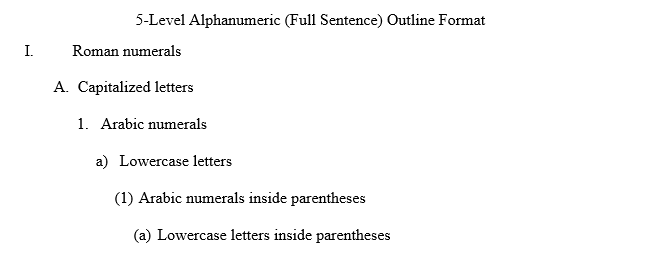
Decimal
A decimal outline format is another style where writers implement numbers to indicate a hierarchy of discussed points. For example, decimal formats of representing headings and subheadings serve as hierarchical representations of discussed ideas (Mentan, 2022). Hence, a 5-level style framework is presented below:
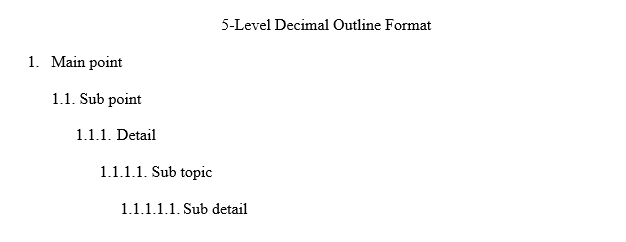
Short or Topic
Short or topic outline formats are useful in organizing short essays from 1 to 5 pages for about 250-1,250 words. Since final papers must not be long or complex, topic outlines can help to start writing or defining points of introduction, body, and conclusion parts (Matthews, 2023). In turn, people do not have to stick strictly to their outlines as they write because it is a flexible plan that can be adjusted as their ideas develop. Moreover, when writing essays, unnecessary ideas may be replaced by others, depending on the information that has been researched. As a result, an example of this framework type looks like:
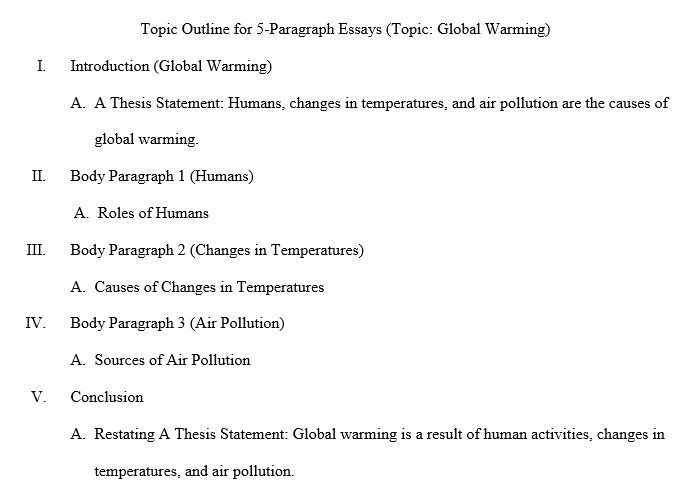
Extended or Sentence
Extended sentence outline formats are useful in writing essays with a detailed structure or papers from 5 pages. In this case, people can use either full sentences or brief phrases in their paper outlines, depending on their preference and a particular level of detail they need to guide their writing process. Moroever, long papers require a detailed analysis and a lot of information with evidence (Busse & August, 2020). In turn, during an analysis process and when organizing essays or other types of papers, students use sentence structures, not missing the information they have gained. Thus, an example of a short or topic framework is:
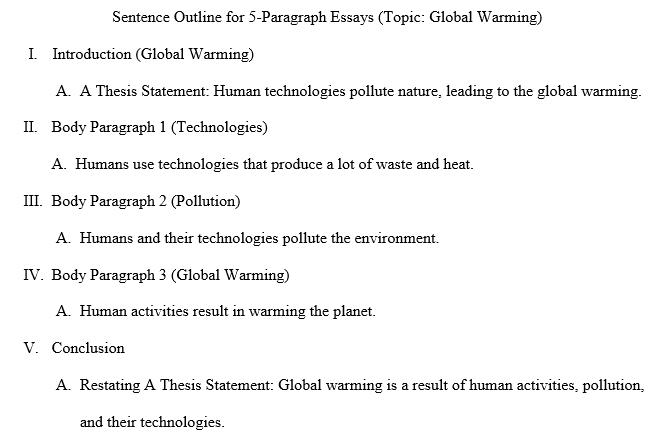
What to Include
| Element | Description |
|---|---|
| Examples | Specific instances or case studies to illustrate points. |
| Statistics | Numerical data to support arguments. |
| Numerical data to support arguments. | Relevant quotes from experts or authoritative sources. |
| Definitions | Clarifications of key terms and concepts. |
| Background Information | Contextual details that set up a specific subject. |
| Counterarguments | Opposing viewpoints and rebuttals. |
| Historical Context | Historical background related to a discussed theme. |
| Theories | Relevant theories that underline a particular argument. |
| Personal Anecdotes | Personal stories that relate to a chosen subject. |
| Comparisons | Comparisons with similar or contrasting ideas. |
| Causes and Effects | Analysis of causes and their effects. |
| Predictions | Speculative insights about future developments. |
| Visual Aids | Notes on figures, tables, or diagrams to be included. |
| Literary Devices | Identification of metaphors, similes, or other devices to be used. |
| Research Findings | Key findings from studies or research papers. |
| Legislation and Policies | Relevant laws or policies affecting an issue. |
| Ethical Considerations | Discussion of moral or ethical implications. |
| Cultural References | Cultural aspects or references related to a study theme. |
| Surveys and Polls | Data from surveys or polls to support arguments. |
| Personal Opinions | Personal viewpoints or interpretations to be discussed. |
Common Mistakes
- Lack of Clarity in a Thesis Statement: Failing to clearly define a main argument or purpose of an essay.
- Insufficient Detail: Providing too little information for each section, making it difficult to develop a paper later.
- Overloading an Outline: Including too much detail, which can make a written framework difficult to follow.
- Ignoring Structure: Not organizing a framework draft in a logical order, leading to a disorganized composition.
- Skipping Transitions: Failing to plan smooth transitions between main points, resulting in a lack of coherence.
- Omitting Supporting Evidence: Not including key pieces of evidence or examples that will be used to support main ideas.
- Vague Topic Sentences: Writing topic sentences that are too broad or vague, making it unclear what each paragraph will cover.
- Forgetting a Conclusion: Neglecting to include a conclusion that summarizes main arguments and reinforces a thesis.
- Inflexibility: Being too rigid with a plan and not allowing for adjustments during an entire writing process.
- Ignoring Assignment Guidelines: Not aligning a structure with specific requirements or guidelines provided for an essay.
Summing Up
A particular success of any paper on any theme for college depends not only on writing skills, research, sources, grammar, and knowledge of academic standards but also on a specific organization of plans. Basically, the five parts of an essay outline are an introduction, a thesis statement, body paragraphs covering main points and supporting evidence, counterarguments, and a conclusion. If students do not know how to write a correct plan when starting academic papers, such works will not meet academic standards. In this case, good strategies for writing help authors to organize clear structures of what they want to talk about in further papers. Therefore, writing an excellent paper starts with organizing an essay outline correctly.
References
Busse, C., & August, E. (2020). How to write and publish a research paper for a peer-reviewed journal. Journal of Cancer Education, 36(5), 909–913. https://doi.org/10.1007/s13187-020-01751-z
Chahal, R. S. (2023). Comprehensive English grammar guide: From basics to competitive excellence. Rana Books Uk.
Huisman, B., Saab, N., van Driel, J., & van den Broek, P. (2018). Peer feedback on academic writing: Undergraduate students’ peer feedback role, peer feedback perceptions and essay performance. Assessment & Evaluation in Higher Education, 43(6), 955–968. https://doi.org/10.1080/02602938.2018.1424318
Matthews, J. (2023). How to write a 5-paragraph essay step-by-step: Step-by-step study skills. Independently published.
Mentan, D. T. (2022). English essay writing handbook. Authors’ Tranquility Press.
West, H., Malcolm, G., Keywood, S., & Hill, J. (2019). Writing a successful essay. Journal of Geography in Higher Education, 43(4), 609–617. https://doi.org/10.1080/03098265.2019.1655720

